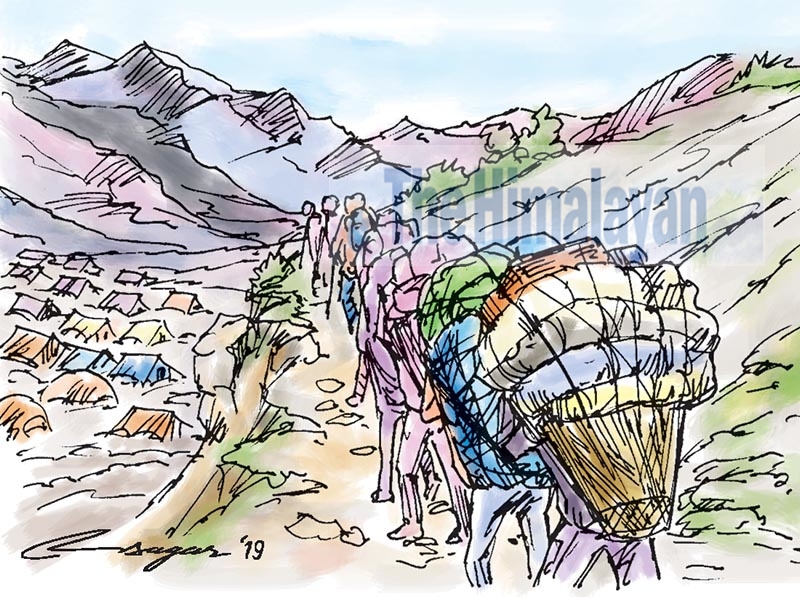Camping trek: Mobile hotel
Old fashioned luxury treks have been replaced by another luxury: hotels, coffee shops, markets, internet on the trek. Such trekking in the Himalayas could be no different from travelling to Sydney or New York
Years ago, we walked to Okhaldhunga on my father’s official business. Porters carried all our needs and cook prepared fresh meals. We camped in patis and temples. This was my first luxurious trekking tour.
Legend has it that a British Army Colonel, Jimmy Roberts, along with Al Read, Mike Cheney and Jim Edwards started commercial luxury camping trekking in Nepal in the late 1969s and early 1970s. This was something similar to what we did years ago when we went to Okhaldhunga but in a far more luxurious way with paraphernalia that we could not have even imagined back then. My father was a guide, trek leader, trail finder, head cook, storyteller, a cashier, a health assistant and staff controller all rolled into one during our trek. The camping trek that Col Roberts and his cohorts pioneered had trained staff for different responsibilities on the trail.
All through the 1970s to 1990s, trekkers mostly went on camping adventures. Till the 1970s and 1980s, camping was the only way to go on treks in Nepal. There were no hotels, lodges or homestays, let alone hospitals, roads and telephones. Sleeping rough in abandoned sheds or under the star was the only cheaper option. By the late 1980s, tea-house trekking had been invented as a cheap, affordable option for backpackers.
But its popularity took off much later. And it is the standard today. For someone like me, tea-house trekking is not really a good option or alternative to camping treks. In 1981, I slept a night at a crowded dormitory motel, sitting on a promontory on the slope of Mt Fuji. While the fellow Japanese trekkers - I was the only foreigner - were very kind, I rued the lack of privacy for personal musings. I hate missing out on wilderness and sleeping on nature’s lap.
On a camping trek, tourists went on adventures the old-fashioned way with a large retinue of staff, including porters, guides, sirdars, cooks, kitchen assistants, and, of course, food, fuel and camping equipment that include tents, mess tent, toilet tent, mattresses, linen, sleeping bags, chairs, tables, kitchen pots and pans, cutlery and crockery. A sirdar is the leader of the team, a supervisor. Fine kitchen staff team conjures up delicious, healthy hot meals. Guides are literally at beck and call. They are always on hand to take care of trekkers’ needs, safety and answer query. Porters carry all camping essentials.
All that a tourist carries with him is his personal needs for the day, including a camera, water bottle, walking stick, sun and reading glasses, a book, snacks like chocolate and medicine. A personal porter could be hired to carry all these encumbrances to allow him to savour the trek without any burden.
A typical day on a camping trek includes an early morning wakeup call along with bed tea, which is followed by a bowl of warm water for washing face and brushing teeth. Breakfast is served soon after in the open alfresco-style. While the guest eats breakfast, the guides would be dismantling and packing up the camping gears. Breakfast includes tea or coffee, milk, fruit juice, cereals, pancakes, roti, bread, butter, jam, honey, marmalade, eggs, sausage, ham, bacon and fruits.
Immediately, after breakfast, the trekkers hit the trails with a guide up front and another right at the back behind the last trekker in a group. Trekkers leave early to avoid heat and to reach the next destination on time or to allow maximum time for local explores. Other guides would mingle with those in between. The kitchen staff would usually leave the camp last and will reach the lunch site ahead. Lunch is usually cold such as vegetarian and non-vegetarian sandwiches, cheese, salad and fruits, served around noon, on the trail. By three or so, the treks finish at the next camping site where trekkers would have tea and cookies for refreshment while the guides and other helpers start setting up the camp, pitching sleeping, mess and toilet tents.
Camping sites are usually at some scenic, interesting places or close to villages within easy access of water sources. Cooks prepare hot supper for the night. Supper would be served three or five-course with entrees, soup, main course - usually continental - desserts and tea/coffee. Supper is always served early except for the final night, which usually ends as a farewell party with drinks, dinner, dancing and tipping. Sometimes the cook would even bake a cake in the pressure cooker for a surprise dessert or a birthday celebration. Day’s adventure stories make the rounds during supper.
Camping treks last from night to as many as three to four weeks or longer.
In the past, to trek in the Everest region or Jomsom, Manang, Mustang or Rara or Kanchenjunga, a flight was a must. You had to fly to trek from Kathmandu or Pokhara unless one had enough disposal time to walk all the way. Regular domestic flight services were highly erratic and disorganised. In fact, all flights to the mountains were subject to strict weather monitoring and limited to mornings. As such, getting on the flights to the mountain was an adventure in itself.
With roads reaching everywhere and hotels cropping up on the trails, camping trek is becoming a thing of the past. Old fashioned luxury treks are replaced by another luxury: hotels, coffee shops, markets, internet on the trek. Such trekking in the Himalayas could be no different from travelling to Sydney or New York.






